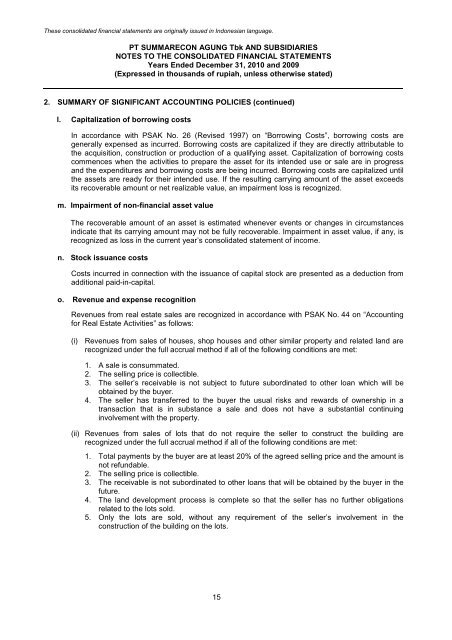PT Summarecon Agung Tbk | Laporan Tahunan 2010 Annual Report
PT Summarecon Agung Tbk | Laporan Tahunan 2010 Annual Report
PT Summarecon Agung Tbk | Laporan Tahunan 2010 Annual Report
Create successful ePaper yourself
Turn your PDF publications into a flip-book with our unique Google optimized e-Paper software.
These consolidated financial statements are originally issued in Indonesian language.<br />
<strong>PT</strong> SUMMARECON AGUNG <strong>Tbk</strong> AND SUBSIDIARIES<br />
NOTES TO THE CONSOLIDATED FINANCIAL STATEMENTS<br />
Years Ended December 31, <strong>2010</strong> and 2009<br />
(Expressed in thousands of rupiah, unless otherwise stated)<br />
2. SUMMARY OF SIGNIFICANT ACCOUNTING POLICIES (continued)<br />
l. Capitalization of borrowing costs<br />
In accordance with PSAK No. 26 (Revised 1997) on “Borrowing Costs”, borrowing costs are<br />
generally expensed as incurred. Borrowing costs are capitalized if they are directly attributable to<br />
the acquisition, construction or production of a qualifying asset. Capitalization of borrowing costs<br />
commences when the activities to prepare the asset for its intended use or sale are in progress<br />
and the expenditures and borrowing costs are being incurred. Borrowing costs are capitalized until<br />
the assets are ready for their intended use. If the resulting carrying amount of the asset exceeds<br />
its recoverable amount or net realizable value, an impairment loss is recognized.<br />
m. Impairment of non-financial asset value<br />
The recoverable amount of an asset is estimated whenever events or changes in circumstances<br />
indicate that its carrying amount may not be fully recoverable. Impairment in asset value, if any, is<br />
recognized as loss in the current year’s consolidated statement of income.<br />
n. Stock issuance costs<br />
Costs incurred in connection with the issuance of capital stock are presented as a deduction from<br />
additional paid-in-capital.<br />
o. Revenue and expense recognition<br />
Revenues from real estate sales are recognized in accordance with PSAK No. 44 on “Accounting<br />
for Real Estate Activities” as follows:<br />
(i) Revenues from sales of houses, shop houses and other similar property and related land are<br />
recognized under the full accrual method if all of the following conditions are met:<br />
1. A sale is consummated.<br />
2. The selling price is collectible.<br />
3. The seller’s receivable is not subject to future subordinated to other loan which will be<br />
obtained by the buyer.<br />
4. The seller has transferred to the buyer the usual risks and rewards of ownership in a<br />
transaction that is in substance a sale and does not have a substantial continuing<br />
involvement with the property.<br />
(ii) Revenues from sales of lots that do not require the seller to construct the building are<br />
recognized under the full accrual method if all of the following conditions are met:<br />
1. Total payments by the buyer are at least 20% of the agreed selling price and the amount is<br />
not refundable.<br />
2. The selling price is collectible.<br />
3. The receivable is not subordinated to other loans that will be obtained by the buyer in the<br />
future.<br />
4. The land development process is complete so that the seller has no further obligations<br />
related to the lots sold.<br />
5. Only the lots are sold, without any requirement of the seller’s involvement in the<br />
construction of the building on the lots.<br />
15


